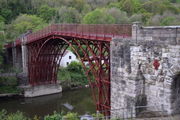Ironbridge
Ironbridge is all that goes around the first cast-iron bridge (1779) built in Shropshire, England by the wondrous Abraham Darby dynasty (number III for the bridge itself), who started the Industrial Revolution there (?!). After the British habit of naming places literally after their landmarks, this became the name of the town that sits by the bridge and rechristened the Severn gorge as the Ironbridge Gorge.

The Bridge
The hero of this story. Started building in 1779, opened for New-Year's Eve 1781! What a day this must have been... On our first attempt to admire this treasure of engineering, we were thwarted by scaffolding, which was a bitter disappointment, especially as these had been there for a long time and were just about to be removed. We returned as the closing event of our trip in Wales and could marvel at its stunning beauty. A perfect conclusion to a trip full of wonders.
-
The sight we were longing for!
-
Julia by the bars which changed the face of the World.
-
Discussion on the bridge.
-
View from the other side.
-
Such an elegant fusion between nature and industry.
-
Below the structure.
The Town
It developed around the Bridge, which became extremely and rapidly popular, both for its transit and later on as a touristic attraction (crowned by a UNESCO recognition for the gorge itself, in 1986 [1]).
St Luke's Church (1837) has the unusual design of its sanctuary at the west end and the tower at the east (in reverse to the majority of churches), because the land at the west end was unstable and unable to take the weight of a tower.
At the eastern end of Ironbridge stand the remains of two 18th century blast furnaces, the Bedlam Furnaces, built in 1757. Also of importance is the spectacular Hay Inclined Plane, which connected the Shropshire Canal to the Coalport Canal, which in turn linked with the River Severn.
Ironbridge Gorge
Originally called the Severn gorge before the Ironbridge takeover, its rich content of useful material (iron, clay) and the Severn providing a ready access to the sea made this place an optimum point to trigger the Industrial Revolution.





